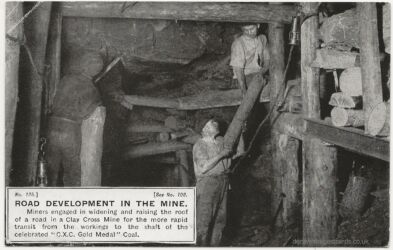Clay Cross is a former industrial and mining town.
This old Derbyshire postcard shows work in one of the many mines in the area,
The High Street was built over a pre-dating Roman road, that may have been called Ryknild street, where a tollhouse (1786-1876) was situated. The discovery of coal in the area, introduced the village to the Industrial Revolution. Packhorses at first transported the ‘blackgold’ over the Peaks on a turnpike road opened in 1756 between the iron foundries of Derby and Sheffield. Until the early 19th century, t was a small village known as Clay Lane, but increasing demand for coal and other minerals trebled the population by 1840, the oldest building being the George and Dragon Inn. While driving the tunnel for the North Midland Railway, George Stephenson discovered both coal and iron, which together with the demand for limestone, caused him to move into Tapton Hall, near Chesterfield, and set up business as George Stephenson and Co.
A map of 1833 showed Thanet Street and Clay Lane. The railway ‘mania’ of 1840s witnessed expansion northwards facilitated by the Clay Cross tunnel dug in 1837-38. Whilst tunnelling over a mile underground they discovered vast quantities of commercial grade coal. Clay Cross became a boom town. The ‘Liverpool Party’ of Stephenson engineers formed the Clay Cross Company in 1839 which they funded from their considerable resources. As well as sinking a number of shafts with colliery support, there were coke oven works, brickworks, limeworks, irons furnaces and foundry. The ductile pipe was developed into an internationally sold product, making Clay Cross renowned for its iron and coal industry worldwide. Although the company had been formed to mine coal and manufacture coke from the railway, the supplies from Durham were preferred, and the works turned to iron working and brick making. When Stephenson died in 1848 his son, Robert, took over, leaving the company in 1852 when it became formally known by the name of the Clay Cross Company. In 1871 the Jackson family acquired 100% of the stocks and shares. They continued as owners until 1974. For many years, the company was the town’s major employer. In 1985 Biwater took it over. In December 2000 Biwater sold the site to French company, Saint-Gobain. Some months later, it was closed down with the loss of around 750 jobs. Demolition of the vast Biwater site began in late 2008, and new houses and shops are appearing in the town.
In 1925 the Ashover Light Railway was opened to transport minerals from the quarries at Ashover Butts to the Clay Cross Company at Egstow. The passenger services on the narrow gauge line were closed in 1936 and the mineral traffic ceased in 1950.



